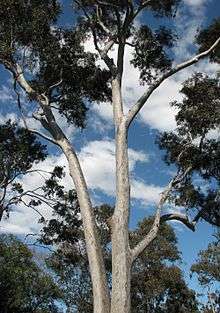Corymbia maculata
| Spotted Gum | |
|---|---|
 | |
| Scientific classification | |
| Kingdom: | Plantae |
| (unranked): | Angiosperms |
| (unranked): | Eudicots |
| (unranked): | Rosids |
| Order: | Myrtales |
| Family: | Myrtaceae |
| Genus: | Corymbia |
| Species: | C. maculata |
| Binomial name | |
| Corymbia maculata (Hook.) K.D. Hill & L.A.S.Johnson | |
Corymbia maculata (syn. Eucalyptus maculata), commonly known as Spotted Gum, is an endemic Australian tree.
Description
Spotted Gum is a tall tree with a straight trunk, growing up to 45 metres in height (sometimes taller). However, there is an old reference to a 91 metre tall tree.[1] Spotted Gum has smooth powdery bark which is white, grey or pink; often with characteristic patches ("spots"). The bark is shed in polygonal flakes.
The juvenile leaves are glossy green and elliptic to ovate, while the adult leaves are lanceolate and are 10 to 21 cm long and 1.5 to 3 cm wide.
It has small, white flowers occur from winter to spring followed by ovoid or slightly urceolate fruits, which are 10 to 14 mm long and 9 to 11 mm wide.
Umbellasters 3-flowered; peduncle terete, 5–20 mm long; pedicels terete, 3–7 mm long. Buds ovoid, 10–11 mm long, 6–7 mm diam., scar usually absent; calyptra hemispherical or rostrate, shorter than and as wide as hypanthium.
Fruit ovoid or slightly urceolate, 10–14 mm long, 9–11 mm diam.; disc depressed; valves enclosed.
Taxonomy

The species was first formally described by William Jackson Hooker in 1844, and given the name Eucalyptus maculata. The specific name maculata is derived from the Latin word maculosus, meaning "spotted" (referring to the spotted pattern on the irregularly-shed bark). The species was transferred to the genus Corymbia by K.D.Hill & L.A.S.Johnson in 1995.
A number of natural hybrids between Corymbia maculata and other Corymbia species have been identified as follows:
- × C. citriodora - known as "C. variegata", occurs in New South Wales
- × C. gummifera - known as Eucalyptus x nowraensis, occurs in southern New South Wales
- × C. intermedia - occurs in New South Wales
Distribution
Corymbia maculata is a dominant species of open forest in Queensland, New South Wales and Victoria. It occurs on infertile and dry sites and is associated with the presence of shales and slates.
The species is naturalised in Western Australia and South Australia, and in areas of New South Wales and Victoria outside its natural range.
Ecological aspects
The flowers attract honeyeaters.
Cultivation
The species is often used for planting in parks and as a street tree, however its mature size makes it unsuitable for most home gardens.
Uses
The hard and durable timber is utilised for a number of purposes.
See also
References
- "Corymbia maculata (Hook.) K.D. Hill & L.A. Johnson". Australian Plant Name Index (APNI), IBIS database. Centre for Plant Biodiversity Research, Australian Government.
- Association of Societies for Growing Australian Plants (ASGAP) Corymbia maculata
- PlantNET - New South Wales Flora Online: Corymbia maculata